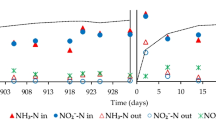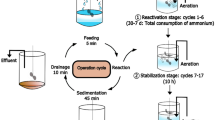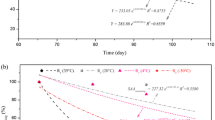Abstract
Due to the slow growth rate of anammox bacteria, enriched sludge is required for the rapid start-up of anammox-based reactors. However, it is still unclear if long-term stored anammox sludge (SAS) is an effective source of inoculum to accelerate reactor start-up. This study explored the reactivation of long-term SAS and developed an efficient protocol to reduce the start-up period of an anammox reactor. Although stored for 13 months, a low level of the specific anammox activity of 28 mg N/g VSS/d was still detected. Experimental Phase 1 involved the direct application of SAS to an upflow sludge bed reactor (USB) operated for 90 d under varying conditions of hydraulic retention time and nitrogen concentrations. In Phase 2, batch runs were executed prior to the continuous operation of the USB reactor. The biomass reactivation in the continuous flow reactor was unsuccessful. However, the SAS was effectively reactivated through a combination of batch runs and continuous flow feed. Within 75 days, the anammox process achieved a stable rate of nitrogen removal of 1.3 g N/L/day and a high nitrogen removal efficiency of 84.1 ± 0.2%. Anammox bacteria (Ca. Brocadia) abundance was 37.8% after reactivation. These overall results indicate that SAS is a feasible seed sludge for faster start-up of high-rate mainstream anammox reactors.





Similar content being viewed by others
Data availability
Sequence data are available at the National Center for Biotechnology Information (NCBI—http://www.ncbi.nlm.nih.gov) under project accession number PRJNA983332.
References
APHA, AWWA, WEF (2017) Standard methods for the examination of water and wastewater, American Public Health Association/American Water Works Association/Water Environment Federation, Washington DC, USA
Bettazzi E, Caffaz S, Vannini C, Lubello C (2010) Nitrite inhibition and intermediates effects on Anammox bacteria: a batch-scale experimental study. Process Biochem 45(4):573–580. https://doi.org/10.1016/j.procbio.2009.12.003
Bolsan AC, Bonassa G, Rodrigues HC, Venturin B, Hollas CE, Klanovicz N, de Prá MC, Antes FG, Treichel H, Kunz A (2023) Anammox sludge preservation strategies for short-term reactivation. Wat Air and Soil Poll 234(4):1–10. https://doi.org/10.1007/s11270-023-06287-8
Chen H, Hu HY, Chen QQ, Shi ML, Jin RC (2016) Successful start-up of the anammox process: influence of the seeding strategy on performance and granule properties. Bioresour Technol 211:594–602. https://doi.org/10.1016/j.biortech.2016.03.139
Chen W, Hu F, Li X, Yang W, Feng S, Yang D, Pang W, Lu B (2021) Deciphering the mechanism of medium size anammox granular sludge driving better nitrogen removal performance. Bioresour Technol 336(4):125317
Cho S, Kambey C, Nguyen VK (2020) Performance of anammox processes for wastewater treatment: a critical review on effects of operational conditions and environmental stresses. Water 12:20
Connan R, Dabert P, Khalil H, Bridoux G, Béline F, Magrí A (2016) Batch enrichment of anammox bacteria and study of the underlying microbial community dynamics. J Chem Eng 297:217–228
Dapena-Mora A, Fernández I, Campos JL, Mosquera-Corral A, Méndez R, Jetten MSM (2007) Evaluation of activity and inhibition effects on Anammox process by batch tests based on the nitrogen gas production. Enzyme Microb 40(4):859–865. https://doi.org/10.1016/j.enzmictec.2006.06.018
Ding Z, Ventorino V, Panico A, Pepe O, van Hullebusch ED, Pirozzi F, Bourven I, Guibaud G, Esposito G (2017) Enrichment of anammox biomass from different seeding sludge: process strategy and microbial diversity. Wat Air and Soil Poll 228(1):1–13. https://doi.org/10.1007/s11270-016-3181-8
Ganesan S, Vadivelu VM (2020) Effect of storage conditions on maintaining anammox cell viability during starvation and recovery. Bioresour Technol 296:122341. https://doi.org/10.1016/j.biortech.2019.122341
He S, Yang W, Qin M, Mao Z, Niu Q, Han M (2018) Performance and microbial community of anammox in presence of micro-molecule carbon source. Chemosphere 205:545–552. https://doi.org/10.1016/j.chemosphere.2018.04.136
Jaroszynski LW, Cicek N, Sparling R, Oleszkiewicz JA (2011) Importance of the operating pH in maintaining the stability of anoxic ammonium oxidation (anammox) activity in moving bed biofilm reactors. Bioresour Technol 102(14):7051–7056
Jin R, Zheng P, Hu A, Mahmood Q, Hu B, Jilani G (2008) Performance comparison of two anammox reactors: SBR and UBF. J Chem Eng 138:224–230
Li J, Zhu W, Dong H, Wang D (2017) Performance and kinetics of ANAMMOX granular sludge with pH shock in a sequencing batch reactor. Biodegradation 28(4):245–259. https://doi.org/10.1007/s10532-017-9793-x
Li D, Li W, Zhang D, Zhang K, Lv L, Zhang G (2023) Performance and mechanism of modified biological nutrient removal process in treating low carbon-to-nitrogen ratio wastewater. Bioresour Technol 367:128254. https://doi.org/10.1016/j.biortech.2022.128254
Martins TH, Souza TSO, Varesche MBA (2017) The influence of stirring speed, temperature and initial nitrogen concentration on specific anammox activity. Braz Arch Biol Technol 60(2):1–11. https://doi.org/10.1590/1678-4324-2017160421
Mulder A, van de Graaf AA, Robertson LA, Kuenen JG (1995) Anaerobic ammonium oxidation discovered un a denitrifying fluidized bed reactor. FEMS Microbiol Ecol 16:117–184
Peng Z, Lei Y, Liu Y, Wan X, Yang B, Pan X (2022) Fast start-up and reactivation of anammox process using polyurethane sponge. Biochem Eng J 177:108249. https://doi.org/10.1016/j.bej.2021.108249
Pereira TDS, Spindola RH, Rabelo CABS, Silveira NC, Adorno MAT, Kunz A, Pires EC, Damianovic MHRZ (2021) A predictive model for N2O production in anammox-granular sludge reactors: combined effects of nitrite/ammonium ratio and organic matter concentration. J Environ Manage 297:113295. https://doi.org/10.1016/j.jenvman.2021.113295
Rahimi S, Modin O, Mijakovic I (2020) Technologies for biological removal and recovery of nitrogen from wastewater. Biotechnol Adv 43:107570. https://doi.org/10.1016/j.biotechadv.2020.107570
Reino C, Carrera J (2017) Low-strength wastewater treatment in an anammox UASB reactor: effect of the liquid upflow velocity. Chem Eng J 313:217–225. https://doi.org/10.1016/j.cej.2016.12.051
Rikmann E, Zekker I, Tenno T, Saluste A, Tenno T (2018) Inoculum-free start-up of biofilm- and sludge-based deammonification systems in pilot scale. Int J Environ Sci Technol 15(1):133–148. https://doi.org/10.1007/s13762-017-1374-3
Rothrock MJ, Vanotti MB, Szögi AA, Gonzalez MCG, Fujii T (2011) Long-term preservation of anammox bacteria. Appl Microbiol Biotechnol 92:147–157. https://doi.org/10.1007/s00253-011-3316-1
Silveira NC, Oliveira GHD, Damianovic MHRZ, Foresti E (2021) Two-stage partial nitrification-anammox process for nitrogen removal from slaughterhouse wastewater: evaluation of the nitrogen loading rate and microbial community analysis. J Environ Manage 296:1–10. https://doi.org/10.1016/j.jenvman.2021.113214
Strous M, Heijnen JJ, Kuenen JG, Jetten MSM (1998) The sequencing batch reactor as a powerful tool for the study of slowly growing anaerobic ammonium-oxidizing microorganisms. Appl Microbiol Biotechnol 50(5):589–596. https://doi.org/10.1007/s002530051340
Tang CJ, Zheng P, Mahmood Q, Chen JW (2009) Start-up and inhibition analysis of the anammox process seeded with anaerobic granular sludge. J Ind Microbiol Biotechnol 36(8):1093–1100. https://doi.org/10.1007/s10295-009-0593-0
Trinh HP, Lee S, Jeong G, Yoon H, Park H (2021) Recent developments of the mainstream anammox processes: challenges and opportunities. J Environ Chem Eng 9:105583. https://doi.org/10.1016/j.jece.2021.105583
van De Graaf AA, De Bruijn P, Robertson LA, Jetten MSM, Kuenen JG (1996) Autotrophic growth of anaerobic ammonium-oxidizing micro-organisms in a fluidized bed reactor. Microbiology 142(8):2187–2196. https://doi.org/10.1099/13500872-142-8-2187
van der Star WRL, Abma WR, Blommers D, Mulder JW, Tokutomi T, Strous M, Picioreanu C, van Loosdrecht MCM (2007) Startup of reactors for anoxic ammonium oxidation: experiences from the first full-scale anammox reactor in Rotterdam. Water Res 41(18):4149–4163. https://doi.org/10.1016/j.watres.2007.03.044
Verma S, Daverey A, Lin JG (2021) Successful start-up of anammox process from activated sludge and anaerobic sludge in a sequencing batch reactor using an unconventional strategy. Int Biodeterior Biodegrad 156(August 2020):105132. https://doi.org/10.1016/j.ibiod.2020.105132
Viancelli A, Pra MC, Scussiato LA, Cantão M, Ibelli AMG, Kunz A (2017) Preservation and reactivation of Candidatus Jettenia asiatica and Anammoxoglobus propionicus using different preservative agents. Chemosphere 186:453–458. https://doi.org/10.1016/j.chemosphere.2017.07.053
Wang T, Zhang H, Yang F (2016) Long-term storage and subsequent reactivation of anammox sludge at 35°C. Desalin Water Treat 57(52):24716–24723
Wang C, Wu H, Zhu B, Song J, Lu T, Li Y, Niu Q (2020) Investigation of the process stability of different anammox configurations and assessment of the simulation validity of various anammox-based kinetic models. RSC Adv 10:39171
Wang S, Yu H, Su Q, Zuo J (2021) Exploring the role of heterotrophs in partial nitritation-anammox process treating thermal hydrolysis process - anaerobic digestion reject water. Bioresour Technol 341(2):125762. https://doi.org/10.1016/j.biortech.2021.125762
Wu G, Zhang T, Gu M, Chen Z, Yin Q (2020) Review of characteristics of anammox bacteria and strategies for anammox start-up for sustainable wastewater resource management. Water Sci Technol 82(9):1742–1757
You Q, Wang J, Qi G, Zhou Y, Guo Z, Shen Y, Gao X (2020) Anammox and partial denitrification coupling: a review. RSC Adv 10:12554–12572
Yuan Q, Jia Z, Roots P, Wells G (2023) A strategy for fast anammox biofilm formation under mainstream conditions. Chemosphere 318(January):137955
Zhang W, Zhang Y, Li L, Zhang X, Jin Y (2014) Fast start-up of expanded granular sludge bed (EGSB) reactor using stored Anammox sludge. Water Sci Technol 69(7):1469–1474. https://doi.org/10.2166/wst.2014.030
Zhao Y, Liu S, Jiang B, Feng Y, Zhu T, Tao H, Tang X, Liu S (2018) Genome-centered metagenomics analysis reveals the symbiotic organisms possessing ability to cross-feed with anammox bacteria in anammox consortia. Environ Sci Technol 52(19):11285–11296. https://doi.org/10.1021/acs.est.8b02599
Zhao Y, Bu C, Yang H, Qiao Z, Ding S, Ni SQ (2020) Survey of dissimilatory nitrate reduction to ammonium microbial community at national wetland of Shanghai. China Chemosphere 250:126195. https://doi.org/10.1016/j.chemosphere.2020.126195
Zhu W, van Tendeloo M, Xie Y, Timmer MJ, Peng L, Vlaeminck SE (2022) Storage without nitrite or nitrate enables the long-term preservation of full-scale partial nitritation/anammox sludge. Sci Total Environ 806:151330. https://doi.org/10.1016/j.scitotenv.2021.151330
Funding
This work was financially supported by the São Paulo Research Foundation (FAPESP) (grant numbers 2020/09912–6 and 2021/12399–1) and the Coordination for the Improvement of Higher Education Personnel (CAPES).
Author information
Authors and Affiliations
Contributions
Conceptualization: Paula Yumi Takeda, Márcia Helena Rissato Zamariolli Damianovic; methodology: Paula Yumi Takeda, Márcia Helena Rissato Zamariolli Damianovic; formal analysis and investigation: Paula Yumi Takeda, Carolina Tavares Paula, Márcia Helena Rissato Zamariolli Damianovic; writing: Paula Yumi Takeda, Carolina Tavares Paula, Guilherme Lelis Giglio, André do Vale Borges, Tiago Duarte Santos Pereira; funding acquisition: Paula Yumi Takeda, Márcia Helena Rissato Zamariolli Damianovic; supervision: Márcia Helena Rissato Zamariolli Damianovic.
Corresponding author
Ethics declarations
Ethics approval
Not applicable.
Consent to participate
Not applicable.
Consent for publication
All the authors have approved the final version to publish this paper.
Competing interests
The authors declare no competing interests.
Additional information
Responsible Editor: Gerald Thouand
Publisher's Note
Springer Nature remains neutral with regard to jurisdictional claims in published maps and institutional affiliations.
Rights and permissions
Springer Nature or its licensor (e.g. a society or other partner) holds exclusive rights to this article under a publishing agreement with the author(s) or other rightsholder(s); author self-archiving of the accepted manuscript version of this article is solely governed by the terms of such publishing agreement and applicable law.
About this article
Cite this article
Takeda, P.Y., Paula, C.T., Giglio, G.L. et al. Efficient reactivation of anammox sludge after prolonged storage using a combination of batch and continuous reactors. Environ Sci Pollut Res 31, 2408–2418 (2024). https://doi.org/10.1007/s11356-023-31355-1
Received:
Accepted:
Published:
Issue Date:
DOI: https://doi.org/10.1007/s11356-023-31355-1




